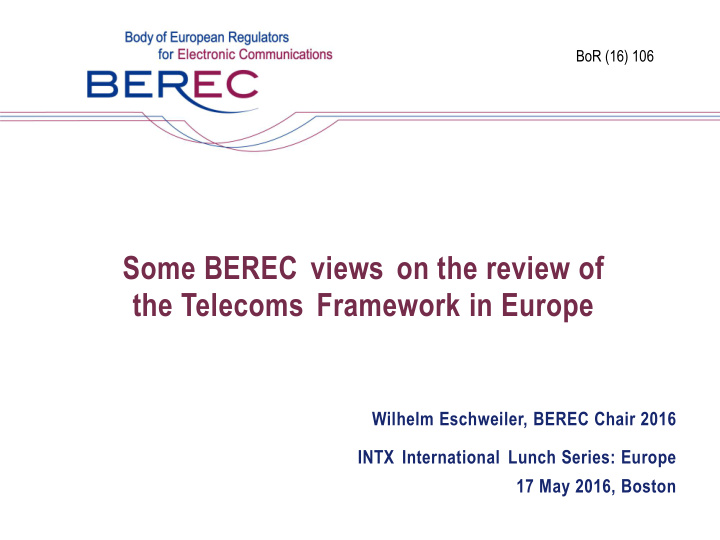



BoR (16) 106 Some BEREC views on the review of the Telecoms Framework in Europe Wilhelm Eschweiler, BEREC Chair 2016 INTX International Lunch Series: Europe 17 May 2016, Boston
Starting point: Current Regulatory framework & its instruments have proven successful & effective balanced set of regulatory objectives and principles Regulatory toolbox Independence of NRAs 2
“Re -fresh regulatory framework ”? Preserving roots of its success Keep balanced set of objectives Keep the principle of technological neutrality Further flexibility of the regulatory toolbox Different set of challenges in Member States Tailor made pro-competitive regulation Independence of NRAs is of key importance Need to align minimum competences of NRAs to ensure BEREC’s remit Ensure financial/operational independence of NRAs 3
Key issues Framework Review Framework review Access Spectrum OTT regulation 4
Access Regulation (1) Effective competition will remain key to incentivise investment Mix of different instruments needed NRA flexibility to choose most adequate instrument Best technological solution Best model of competition 5
Access Regulation (2): investment incentives Effective competition drives innovation and investment Regulatory environment to remain open to competition Large number of telcos across EU EEA: increasing market shares of altnets decreasing market shares of incumbents Investment in broadband networks (period 2006-2015) : xDSL subscriptions 70% cable 18% FTTH/B emerging Variety of offers: telecoms services, fixed voice, internet access services, mobile data, mobile voice Decreasing prices for consumers EU framework includes flexibility, i.e. regulatory toolbox to find best technological solution and best model of competition 6
Access Regulation (3): oligopolies Adapt regulatory toolbox to market changes Significant M&A activities in Europe leading to oligopolies: Market structure changing mostly from 4 to 3 players Mostly mobile markets, e.g. mergers AT, IE, DE, and ongoing case in UK Why are we concerned? Less players Less competitive pressure Less competition: price increase, decreasing variety of offers What could we do when there is a need? Symmetric regulation Monitor market conduct and intervene in case of need 7
Spectrum European and global coordination is essential regarding spectrum for electronic communication services is already a reality Evaluate existing extensive tools to harmonise spectrum for electronic communications services, set timelines for the availability and enforcing (Problems? If so how to tackle?) Spectrum essential input to achieve EU connectivity targets Further (top down) harmonisation bears risks resulting in inefficient use of spectrum Instead promoting harmonised approaches to spectrum management bottom-up with best practices 8
OTT (1) Provision of internet-based services (OTTs) of increasingly importance and of great value for consumers/businesses Boundary between traditional telecom services and content services becomes more and more blurred NRAs role to monitor market developments (impact of new players/business models) on telecom markets Future scope of framework needs to be carefully considered in order to keep pace with the current technological developments to ensure competitive dynamics and adequate consumer protection 9
OTT (2) Clear focus on “OTT - 1” services which potentially compete with /are considered to be substitutes to electronic communications services “Level playing field” – careful assessment required reason to reduce the scope of regulation? reason to increase the scope of regulation? On- going BEREC “rule by rule assessment” in the light of policy objectives and proportionality 10
Conclusions / outlook Framework review is a chance for reflection ahead BEREC ready to deliver and to provide its input Key to retain independence of BEREC to maintain regulatory expertise BEREC‘s rootedness in independent NRAs must remain at the heart of regulatory system Current BEREC work focusing on key framework review issues inter alia access regulation, spectrum and OTT issues Transatlantic dialogue important to learn from each other 11
Many thanks for your attention! BEREC documents are published on the BEREC website: http://berec.europa.eu 12
Recommend
More recommend